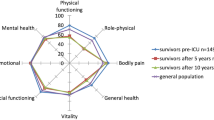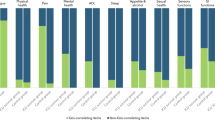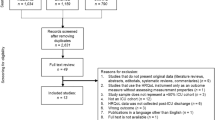Abstract
Objective
To study whether the Short Form-36 questionnaire can be used to assess the patient's quality of life on admission to the ICU by use of proxies in both scheduled and emergency admissions.
Design and setting
Prospective study involving direct interviews of patients and relatives before or during ICU stay in a 10-bed mixed intensive care unit in a 654-bed university affiliated hospital.
Patients and participants
Patients before major elective surgery (n=55) or following emergency admissions (n=57).
Measurements and results
Patients and proxies completed a health questionnaire in the first 72 h following emergency admission or the day before a scheduled admission to the ICU. Internal consistency was evaluated by measurement of Cronbach's α. All dimensions of the SF-36 had adequate internal consistency. On all eight dimensions a significant correlation was found between the patient and their proxy. In general, proxies underestimated the patient's quality of life although differences were small (less than 5%). On most items a good to very good agreement was found (α>0.6). Quality of life assessment was not affected by the admission status of the patient (acute or elective admission and surgical or medical diagnosis).
Conclusions
The SF-36 questionnaire completed by a proxy can reliable assesses the quality of life of the critically ill patient on admission to the ICU. Proxies underestimated the patient's quality of life, although the differences were small.
Similar content being viewed by others
References
Thibault GE, Mulley AG, Barnett GO, Goldstein RL, Reder VA, Sherman EL, Skinner ER (1980) Medical intensive care: indications, interventions, and outcomes N Engl J Med 302:938–942
Patrick DL, Danis M, Southerland LI, Hong G (1988) Quality of life following intensive care J Gen Intern Med 3:218–223
Suter PM, Armaganidis A, Beaufils F, Bonfill X, Burchardi H, Cook DJ, Fagot-Largeault A, Thijs LG, Vesconi S, Williams AJ (1994) Consensus conference: Predicting outcome in ICU patients Intensive Care Med 20:390–397
Rogers J, Ridley S, Chrispin P, Scotton H, Lloyd D (1997) Reliability of the next of kins' estimates of critically ill patients' quality of life Anaesthesia 52:1137–1143
Wehler M, Hadzionerovic D, Aljukic E, Reulbach U, Hahn EG, Strauss R (2002) Health-related quality of life of multiple organ dysfunction patients: changes and comparison with normative population data Crit Care 6: S118-
Goldstein RL, Campion EW, Thibault GE, Mulley AG, Skinner E (1986) Functional outcomes following medical intensive care Crit Care Med 14:783–788
Yinnon A, Zimran A, Hershko C (1989) Quality of life and survival following intensive medical care Q J Med 71:347–357
Vazquez MG, Rivera FR, Gonzalez CA, Delgado-Rodriguez M, Torres Ruiz JM, Raya PA, Aguayo DH (1992) Factors related to quality of life 12 months after discharge from an intensive care unit Crit Care Med 20:1257–1262
Ware JE (1993) SF-36 Health survey manual and interpretation guide. Health Institute–New England Medical Center, Boston
Brazier JE, Harper R, Jones NM, O'Cathain A, Thomas KJ, Usherwood T, Westlake L (1992) Validating the SF-36 health survey questionnaire: new outcome measure for primary care BMJ 305:160–164
Jenkinson C, Coulter A, Wright L (1993) Short form 36 (SF36) health survey questionnaire: normative data for adults of working age BMJ 306:1437–1440
Chrispin PS, Scotton H, Rogers J, Lloyd D, Ridley SA (1997) Short Form 36 in the intensive care unit: assessment of acceptability, reliability and validity of the questionnaire Anaesthesia 52:15–23
Aaronson NK, Muller M, Cohen PD, Essink-Bot ML, Fekkes M, Sanderman R, Sprangers MA, te Velde A, Verrips E (1998) Translation, validation, and norming of the Dutch language version of the SF-36 Health Survey in community and chronic disease populations J Clin Epidemiol 51:1055–1068
Polit DF, Hungler BP (1995) Nursing research principles and methods. Lippencott, Philadelphia
Bland JM, Altman DG (1986) Statistical methods for assessing agreement between two methods of clinical measurement. Lancet I:307–310
Mahler DA, Mackowiak JI (1995) Evaluation of the short-form 36-item questionnaire to measure health-related quality of life in patients with COPD Chest 107:1585–1589
Anderson C, Laubscher S, Burns R (1996) Validation of the Short Form 36 (SF-36) health survey questionnaire among stroke patients Stroke 27:1812–1816
Capuzzo M, Grasselli C, Carrer S, Gritti G, Alvisi R (2000) Quality of life before intensive care admission: agreement between patient and relative assessment Intensive Care Med 26:1288–1295
Heyland DK, Hopman W, Coo H, Tranmer J, McColl MA (2000) Long-term health-related quality of life in survivors of sepsis. Short Form 36: a valid and reliable measure of health-related quality of life Crit Care Med 28:3599–3605
Rothman ML, Hedrick SC, Bulcroft KA, Hickam DH, Rubenstein LZ (1991) The validity of proxy-generated scores as measures of patient health status Med Care 29:115–124
Badia X, Diaz-Prieto A, Rue M, Patrick DL (1996) Measuring health and health state preferences among critically ill patients Intensive Care Med 22:1379–1384
Sprangers MA, Aaronson NK (1992) The role of health care providers and significant others in evaluating the quality of life of patients with chronic disease: a review J Clin Epidemiol 45:743–760
Acknowledgements
We thank Rogier Donders, Department of Biostatistics, University Medical Center, Utrecht, for his help in analysis of the data. This work was rewarded with "Best-Poster Award" at the annual meeting of the European Society of Intensive Care in Rome 2000.
Author information
Authors and Affiliations
Corresponding author
Rights and permissions
About this article
Cite this article
Hofhuis, J., Hautvast, J.L.A., Schrijvers, A.J.P. et al. Quality of life on admission to the intensive care: can we query the relatives?. Intensive Care Med 29, 974–979 (2003). https://doi.org/10.1007/s00134-003-1763-6
Received:
Accepted:
Published:
Issue Date:
DOI: https://doi.org/10.1007/s00134-003-1763-6




